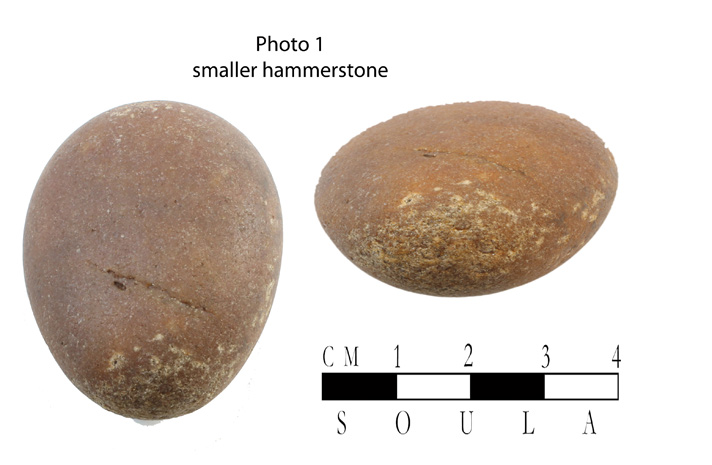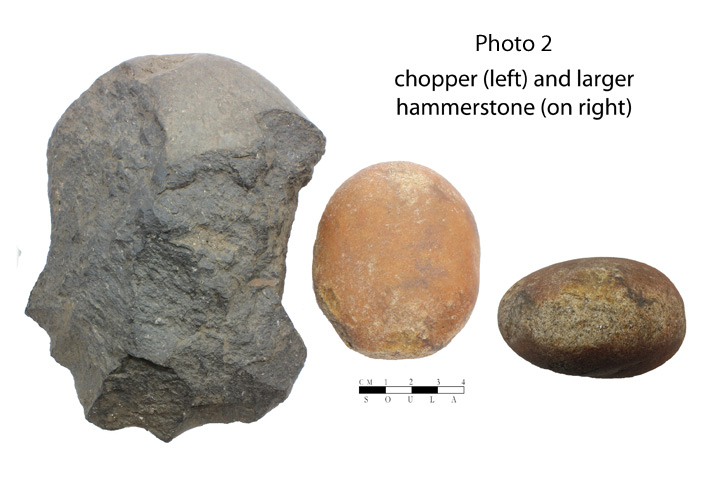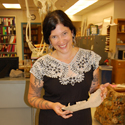Digging Jacksonville – September 2017
“Be they ever so humble looking,” each of the three Native tools shown here were of crucial importance to their owner’s survival. All three were found at Hanley Farm, as part of the recent archaeological dig for the Farm’s new septic drain field.
For most of us now living here, it is the arrow points (and other projectile points)—made of finely flaked jasper or obsidian—that cause us to marvel at the skill of our Valley’s ancestral inhabitants. However, an experienced knapper could typically produce several such items within just a few minutes’ time. Today, few of us possess such skills, so we’re understandably impressed by such artifacts.
In contrast to projectile points (which often broke or were lost during hunting), the three artifacts illustrated here were probably used over-and-over, throughout many years of camping along Jackson Creek at present Hanley Farm. Thus, they would have been of far more long-term value to the owner than any arrow point.
Two of the three tools shown here are alluvial (i.e., river-rounded) cobbles of quartzite that were used as “hammerstones.” Quartzite is a very hard, dense metamorphic rock formed millions of years ago from quartz sandstone. These cobbles eroded out of the ancient sedimentary deposits of the Payne Cliffs Formation, which are exposed here and there in the Bear Creek Valley (including Barneburg Hill, on the summit of which sits Rogue Valley Manor). Note the different size of the scale bar in the two photos: The rounded cobble shown in the first photo is much smaller in actual size than the cobble shown in the other photo. Both of these hammerstones would have been used to flake pieces of jasper, agate, and fine-grained basalt into points, knives, and other items. (Note: side views and end views of both hammerstones are shown.)
These two artifacts show the characteristic peck-mark scars that result from hammering on rocks like jasper and basalt to make chipped-stone arrow points and such. The smaller hammerstone, excavated earlier this year during the SOULA dig at the Hanley drain-field project, bears much less evidence of percussion use on its surface than the other one. It was evidently discarded or lost fairly early in its career as a tool. However, a hammerstone—like a carpenter’s favorite hammer today—could sometimes serve as an owner’s life-long, favorite tool. Over the years, a particular hammerstone’s familiar heft and shape could be employed quite skillfully. Look at the second, larger hammerstone (which was found during the archaeological monitoring of the septic-drain system’s construction): For it to have this abundant amount of deep scarring on its surface, it may well have been used over-and-over for many years by its owner—who would have considered it to be of far more personal importance than any quickly-made arrow point.
The third artifact, which is by far the largest of them, is another alluvial cobble, but this one is of basalt. You can see the remnant of the cobble’s original river-rounded surface near the top. The rest of the artifact has been flaked (and, yes, this was probably done by a quartzite hammerstone) to form a heavy, sharp-edged chopping tool. Because they had no access to metal tools until the 1820s or so, Native people employed such “cobble choppers” for thousands of years. Most likely, this chopper was gripped at its smooth, alluvial end, and used with repeated downward blows to do the same kind of work as would a steel hatchet. Such choppers were used to split wood and to butcher game such as deer or elk. They were especially important in disarticulating the skeletal parts of a carcass—removing limbs from the body—and to smash open an animal’s leg bones for the nutritious marrow. This artifact, too, possibly saw repeated use at what is now Hanley Farm.
Jeff LaLande has lived in the Valley since 1969. He’s an archaeologist and a member of the Southern Oregon Historical Society’s Board of Trustees. You can reach SOULA by contacting Chelsea Rose at rosec@sou.edu and follow SOULA on facebook/Southern Oregon University Laboratory of Anthropology.


 Chelsea Rose is an historical archaeologist who specializes in the settlement and development of the American West. Chelsea and the Southern Oregon University Laboratory of Anthropology (SOULA) conduct archaeology across Oregon and have done several projects in Jacksonville. You can reach Chelsea at rosec@sou.edu and follow SOULA on
Chelsea Rose is an historical archaeologist who specializes in the settlement and development of the American West. Chelsea and the Southern Oregon University Laboratory of Anthropology (SOULA) conduct archaeology across Oregon and have done several projects in Jacksonville. You can reach Chelsea at rosec@sou.edu and follow SOULA on